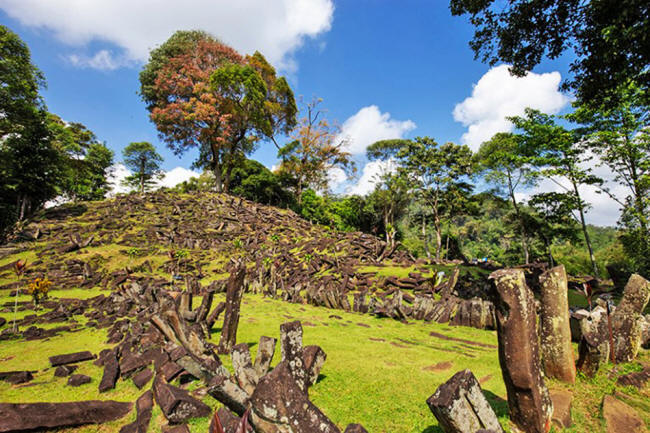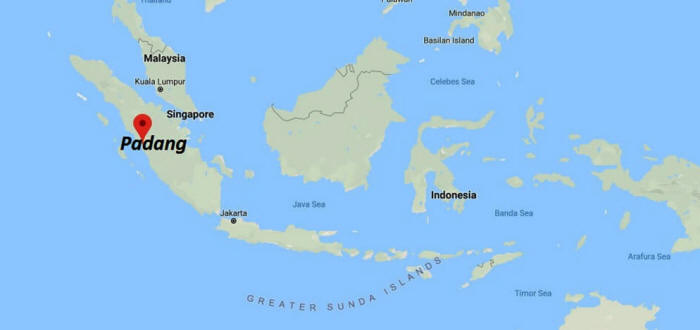|

by Dyani Lewis
28 November
2023
from
Nature Website
Recovered through
WayBackMachine Website
Similar
version in spanish

Gunung Padang
is "an amazing, important and cool site",
but whether
it is the world's oldest stone structure is contested.
Credit: Ali
Trisno Pranoto/Getty
The
massive buried structures
at Gunung Padang
in Indonesia
would be much
older than
Egypt's great
pyramids...
if
they're even
human
constructions at all...
A headline-grabbing paper 1 claiming that a structure in
Indonesia is the oldest pyramid in the world has raised the eyebrows
of some archaeologists - and has now prompted an investigation by
the journal that published it, Nature has learnt.
The paper (Geo-archaeological prospecting of
Gunung Padang buried Prehistoric Pyramid in West Java,
Indonesia), published in the journal Archaeological Prospection on 20
October, garnered headlines around the world.
Its central claim is
that a pyramid lying beneath the prehistoric site of
Gunung Padang
in West Java, Indonesia, might have been constructed as far back as
27,000 years ago.

That would make it much older than the first colossal Egyptian
pyramid, the 4,600-year-old
Pyramid of Djoser.
It would also mean
that it pre-dates the oldest known megalithic site,
Göbekli Tepe in
Turkey, which was built by stone-masons around 11,000 years ago.
And
it would completely rewrite what is known about human civilization
in the area.
"The pyramid has become a symbol of advanced
civilization," says paper co-author Danny Hilman Natawidjaja, a
geologist at the National Research and Innovation Agency (BRIN) in
Bandung, Indonesia.
"It's not easy to build pyramids. You need high
masonry skills," he says.
It's exactly such claims that have left many fellow researchers
cold.
Lutfi Yondri, an archaeologist at BRIN, says his work has
shown that people in the region inhabited caves between 12,000 and
6,000 years ago, long after the pyramid was supposedly built, and no
excavations from this period have revealed evidence of sophisticated
stonemasonry.
"I'm surprised [the paper] was published as is," says
Flint Dibble,
an archaeologist at Cardiff University, UK.
Although the paper
presents "legitimate data", he says, its conclusions about the site
and its age are not justified.
Shaky
foundations
Gunung Padang comprises five stepped stone terraces, with retaining
walls and connecting staircases, that sit atop an extinct volcano.
Between 2011 and 2014, Natawidjaja and colleagues investigated the
site using several ground-penetrating techniques to determine what
lies beneath the terraces.
They identified four layers, which they conclude represent separate
phases of construction. The innermost layer is a hardened lava core,
which has been "meticulously sculpted", according to the paper.
Subsequent layers of rocks "arranged like bricks" were built over
the top of the oldest layer.
The layers were carbon-dated, using
soil lodged between rocks obtained from a core drilled out of the
hill. The first stage of construction, according to the paper,
occurred between 27,000 and 16,000 years ago.
Further additions were
made between 8,000 and 7,500 years ago, and the final layer, which
includes the visible stepped terraces, was put in place between
4,000 and 3,100 years ago.
Dibble says there is no clear evidence that the buried layers were
built by humans and were not the result of natural weathering and
the movement of rocks over time.
"Material rolling down a hill is
going to, on average, orient itself," he says.
But Natawidjaja says
that the column-shaped stones were too large and orderly to have
simply rolled there:
"The neatly arranged, shaped and massive nature
of these rocks, some weighing up to 300 kilograms, dismisses the
likelihood of transportation over significant distances."
The authors also report finding a dagger-shaped stone.
"This
object's regular geometry and distinct composition, and its
materials unrelated to the surrounding rocks, signify its man-made
origin," says Natawidjaja.
But Dibble says it's unlikely that the
rock was shaped by humans.
There's no evidence of,
"working or
anything to indicate that it's man-made", he says.
Extraordinary
claims
The Gunung Padang site featured in the '2022 Netflix documentary'
Ancient Apocalypse, hosted by British author
Graham Hancock, who
promotes an idea that an advanced global civilization was wiped out
12,000 years ago at the end of the last ice age:
Once There Was a Flood
|
Once There Was a Flood
Graham visits
Gunung Padang, an
Indonesian archeological site, to find proof of a lost
civilization - and the potential cataclysm that wiped it
out.
|
The authors
acknowledge Hancock for proofreading their paper.
Natawidjaja says that because Gunung Padang was constructed before
the end of the last ice age, it shows that people from that time
were capable of building complex structures, and,
"this makes it a
very interesting monument".
But Bill Farley, an archaeologist at Southern Connecticut State
University in New Haven, says the paper has not provided evidence
that an advanced civilization existed during the last ice age.
The
27,000-year-old soil samples from Gunung Padang, although accurately
dated, do not carry hallmarks of human activity, such as charcoal or
bone fragments, he says.
Archaeological records show that,
the
transition from hunter-gatherer societies to complex societies
occupying large settlements occurred after the commencement of the
Holocene 11,700 years ago.
The oldest known city is
the 9,000-year-old site of
Çatalhöyük in what is now Turkey.
2
Archaeological Prospection and its publisher,
Wiley, have since
launched an investigation into the paper.
Eileen Ernenwein, an
archaeological geophysicist at Tennessee State University in Johnson
City, who is co-editor of the journal said in an e-mail to Nature:
"The editors, including me, and
Wiley ethics team are currently
investigating this paper in accordance with Committee on Publication
Ethics guidelines."
She declined to elaborate on the nature of the
concerns raised.
Farley says that people should celebrate Gunung Padang for what it
is,
"an amazing, important and cool site",
...rather than because it
can be written into any particular narrative about the development
of human civilization.
Natawidjaja says that he hopes the controversy does not cause
animosity in the community.
"We are really open
to any researchers around the world who would like to come to
Indonesia and do some research program on Gunung Padang," he
says.
"We know very little
about our human history."
References
-
Natawidjaja, D.
H. et al. -
Geo-archaeological prospecting of
Gunung Padang buried Prehistoric Pyramid in West Java,
Indonesia - 20 October 2023
-
Orton, D. et al.
-
A Tale of Two Tells - Dating the
Çatalhöyük West Mound
- 27 June 2018
|



